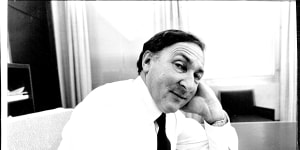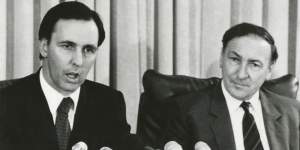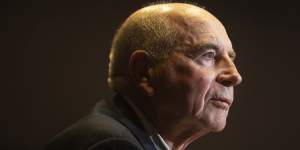Bob Johnston,who also oversaw the country’s first polymer note,supported the decision of then-treasurer Paul Keating and prime minister Bob Hawke in 1983 to float the dollar,whose value until then had been set by a committee of bureaucrats.

Bob Johnston,RBA governor under Paul Keating,was pivotal to the economy’s change through the 1980s.Lorrie Graham
He joined Commonwealth Bank at the age of 16 in 1940. He served in the RAAF during World War II before returning to the bank in 1946 and working in the securities and economics department. At the time,the Commonwealth was the nation’s central bank,with the Reserve created as a standalone institution only in 1960.
In 1976,Johnston became the RBA’s chief representative in London at a time when the value of the Australian dollar was pegged to that of a basket of currencies including the US dollar and the British pound.
After a brief break,he returned to the RBA in 1979 and became involved in the inquiry into the nation’s financial system headed by Sir James Campbell. Its report,delivered to the Fraser government in 1981,recommended a move away from a fixed exchange rate system,the entry of foreign banks and a deregulated banking sector.
Johnston was appointed as governor of the Reserve by then-treasurer John Howard in mid-1982. In a sign of his independence,Johnston pushed back at a proposal in Howard’s 1982 budget that would have forced the bank into moving money out of trading banks directly into the housing market.
Ahead of the March 1983 election,the Reserve Bank struggled to maintain the value of the dollar as overseas investors – in effect encouraged by members of the Coalition,which warned of economic turmoil under a Hawke-Keating government – made massive currency withdrawals from Australia.
One of Keating’s first actions as treasurer was to devalue the Australian dollar,which helped stem the flow of money out of the country.
While Treasury at the time was opposed to deregulating the dollar,Johnston supported the move. In early December 1983,Keating allowed the value of the dollar to be determined by financial markets.
Johnston was involved in the advent of foreign banks into the country through the mid-1980s in a bid to increase competition on Australia’s domestic lenders. He helmed the Reserve Bank through the October 1987 stock market crash and the currency crisis following Keating’s famous “banana republic” commentary about the economy.

Paul Keating and Bob Johnston announce the float of the Australian dollar on December 9,1983.Robert Johnston
During Johnston’s time in charge of the RBA,it produced the world’s first polymer note,a $10 marking the bicentennial of 1988.
His successor as governor in 1989,Bernie Fraser,said on Monday that Johnston had played an important role in the bank and the development of the Australian economy.
He said until the 1980s,the Reserve Bank had sought to deliver price stability through a range of measures that all struggled. These had included tying the value of the Australian currency to gold and,through the 1970s,setting interest rates to the volume of money moving through the economy.
Under Johnston,the bank moved to a “checklist” approach and then to the use of open markets to decide both the value of the currency and interest rates.

Former RBA governor Bernie Fraser says Bob Johnston played an important part in Australia’s economic reforms of the 1980s.Alex Ellinghausen
“It was the market-based framework for interest rates and exchange rates that meant inflation targeting was feasible,” he said.
“The bank has been using inflation targeting for about half of its life now. And when you look over the last 30 years,it’s had inflation at 2.5 per cent for most of that time.
“Bob was very significant in developing what we have in terms of interest rates and the floating of the currency.”
Fraser said Johnston was open to new ideas that helped him adapt to the many changes that took place in economic debate and central banking through the 1970s and 1980s.
“He was a very good central banker. He was very practical rather than ideological when it came to solving problems,” he said.
In a statement,the RBA said Johnston would be remembered for his “sound judgment,integrity and enduring commitment to the advancement of Australia’s central bank”.
Cut through the noise of federal politics with news,views and expert analysis from Jacqueline Maley. Subscribers can sign up to our weekly.